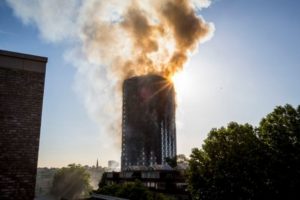Fire Safety
Grenfell: Cladding tests must reflect real life
The Grenfell Tower fire is one of the most significant the UK has seen for years, bringing widespread attention to a number of failures and to a system described by Dame Judith Hackitt as ‘not fit for purpose’.
There was standing-room only at a presentation given last month by the Fire Protection Association’s (FPA’s) Principal Consultant Howard Passey, when he talked about the Hackitt Review and the FPA’s research into the suitability of existing cladding test regimes to deal with modern materials and construction standards. The work has been done in conjunction with the Association of British Insurers (ABI).
There has been a change in the products used to build, said Passey, adding: “We need more awareness of the use of combustible products. A lot has changed as a result of historical fires – Windsor Castle for example. But people weren’t killed there….until Grenfell.

“Grenfell has changed the landscape. A number of failures led to this incident.”
Talking about advice that came from the fire brigade on that fateful night, Passey commented on the “dreadful consequences of the ‘stay put’ fire advice. “I don’t think the approach to this policy will necessarily change but we must recognise that life safety is paramount,” he said.
Talking about Value Engineering (VE), which promotes the substitution of materials and methods with less expensive alternatives, Passey suggested that it can result in uncontrolled, undocumented and poorly designed changes being made to the original design intent. “Lowest cost isn’t always right,” he added.
Stressing that corners should never be cut, Passey voiced caution over the use of fire engineering that entails the removal or reduction of strategies like fewer stairs or removal of sprinklers in order to save money but not provide safety.
Moving on to the Metropolitan Police Investigation into Grenfell, Passey outlined that this is examining evidence in documents from those involved in the refurbishment of the tower, statements from survivors, and a review of CCTV (amongst other avenues). “We should, by the end, have a clearer indication of what went wrong,” he added.
The level of investigation is immense, with a great number of factors to consider. Passey stressed that it is not just cladding that needs to be considered; issues like smoke logging in the stairwell are a factor, which suggests issues with compartmentation; the flat’s front doors which have failed tests clearly show that problems existed, for example.
Hackitt Recommendations
Talking about the recommendations to come out of the Hackitt ‘Independent Review of Building Regulations and Fire Safety’, Passey said: “The government would be stupid to ignore the recommendations, but this means change.
“A Regulatory Framework to focus on multi-occupancy higher risk residential buildings (HRRBs) must recognise that the impact will be far wider than what is currently in the report.
“A holistic approach must be right. The recommendations in isolation will fail to achieve the intended outcome,” he said.
On Monday July 16 Barbour EHS and The Healthy Work Company will be hosting Dame Judith Hackitt for a webinar. More details can be found here…
FPA/ABI test programme
Research commissioned by the ABI and conducted through the FPA has highlighted concerns with the testing regime for the performance of materials used on the outside of buildings. Passey explained that it will be used to support a case of the prescription of non-combustible products in high hazard applications. And it could be used to support a case for understanding whether the government’s appraisal of the at-risk building population is well founded.
Real life testing
Other headlines on this from Passey’s presentation included:
- Cladding test methods: Was the BS 8414 test appropriate? Testing is only necessary if using combustible materials. The FPA found that systems are not necessarily installed to manufacturer instructions.
- Fuel load: It may be necessary to re-evaluate the fuel load to test effective cladding systems. Plastic burns differently to timber, for example.
- ETICS Systems: FPA tests found that as long as the system was properly installed, fire spread was limited.
- Presence of oxygen/air flow: Gives a ‘chimney effect’.
Passey stressed the importance of testing real life situations, commenting that built up systems testing is complex; if real world challenges are to be appreciated (wear and tear, modifications, changing risks, etc.) the outcome could be different. “Be aware that tests don’t replicate real life,” he said.
When talking about materials, a closer look is needed at the use of combustible materials in construction, he told the audience. Materials may not be ‘truly non-combustible’; some materials may not sustain burning but that does not necessarily mean that they are not ‘contributing’ to the fire.
The full report from the FPA/ABI can be read here.
Grenfell: Cladding tests must reflect real life
The Grenfell Tower fire is one of the most significant the UK has seen for years, bringing widespread attention to a number of failures and to a system described by Dame Judith Hackitt as ‘not fit for purpose’.
Alison Fava
SHP - Health and Safety News, Legislation, PPE, CPD and Resources Related Topics
Legal insight: Common errors in fire safety
Tall Buildings High Rise Construction Fire Safety Conference call for papers
Lithium-ion battery fire risks – What you need to know (part three)

